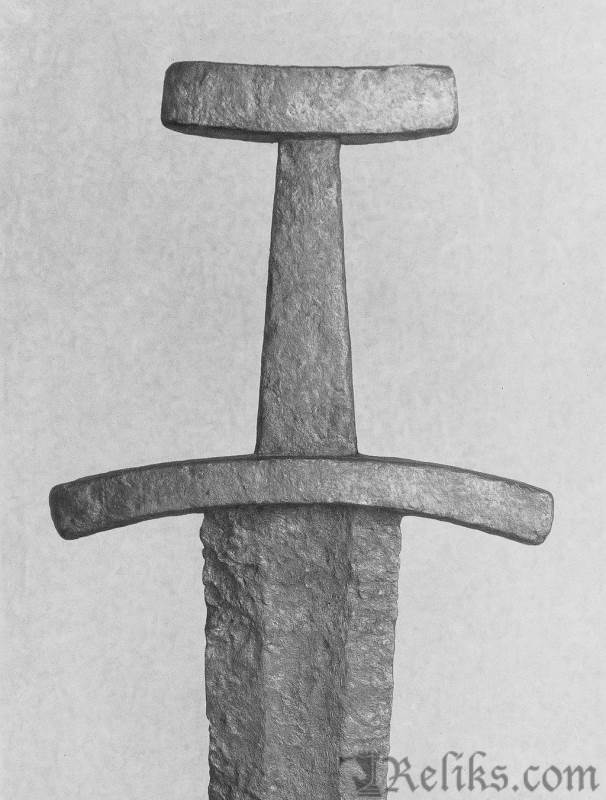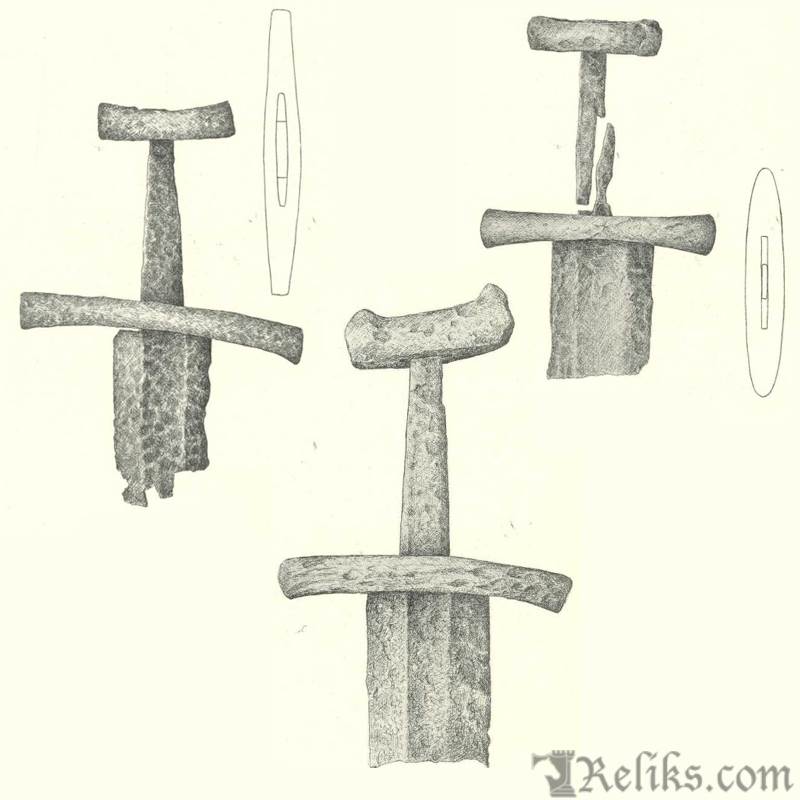Viking Sword Type Q (10th Century)
Defining Features
The Q-type continues the trend set by the M- and P-types: swords with curved guards but no pommel. Both the upper and lower guards bend gently through their length, and in many cases the ends rise slightly higher than the center, giving the sword a distinctive, wave-like silhouette.
The sides of the guards are usually flat, though some examples are more rounded, but never ridged. Several variants exist within this type. The most common, known as R 502, belongs to a later stage and shows expanded ends on the lower guard, along with a more evenly rounded cross-section. In contrast, earlier examples are slimmer, with guards abruptly cut at the ends. The younger specimens often feature longer guards — especially lower guards, which could stretch from 10 cm up to nearly 17 cm, among the longest of the Viking Age.
Unlike many other Viking swords, Type Q swords lacked ornamentation. Their guards were plain, without silver inlay, plating, or pommel attachment. The impression is that of a more practical, locally produced weapon.
Distribution and Examples

Viking Sword Type Q — Common 10th Century Warrior’s Sword
Petersen catalogued 122 examples of Type Q, making it one of the more common late Viking Age forms. Of these, 118 were double-edged, while only four were single-edged — a high ratio compared to many other types.
Like the M-type, the Q-type was strongly concentrated in eastern Norway, particularly in Akershus, Hedmark, Kristians, and Bratsberg. Strikingly, the type is completely absent from Østfold (Smaalenene), where younger swords are generally rare. Only a handful of examples are known from western Norway and Trøndelag, and a very few from Sweden (including Närke) and Denmark. None are recorded outside Scandinavia.
Dating and Archaeological Context

Petersen Sketches (fig.110-112)
Type Q swords are firmly dated to the 10th century, with use extending into the very end of the Viking Age.
The context of associated finds helps narrow down its chronology. Q-type swords often appear alongside spearheads of Type I and K, as well as axes of Types I and K. Earlier types such as F- and C-type spearheads disappear from these contexts, while shield bosses are typically of the low R 563 or R 565 forms. Graves often contained young-style rattles and stirrups, and in double burials, the oval brooches are consistently of 10th-century forms.
Two unusual finds show hybridization with other types:
- A sword from Traalerud (Fjaere) combines a Q-type guard with an L-type lower guard.
- Another from Gile (Østre Toten) shows an upper guard closer to the Æ-type.
These hybrids emphasize the Q-type’s role as a transitional style influenced by earlier and contemporary forms.
Interpretation
Type Q represents a local Norwegian development from the plain, pommel-less M-type, but influenced by the decorated P- and O-types. It takes their curved guard form and strips it of ornament, creating a practical, standardized weapon. Later variants, like R 502, also show influence from the R- and S-types, with more pronounced expansions and longer guards.
The sheer number of surviving examples suggests the Q-type was a workhorse sword of the mid- to late Viking Age. Unlike the ornate, prestige blades marked with inscriptions or precious metals, these were likely accessible to a wider warrior class. They were reliable, functional, and durable — weapons of the farmer-warrior and local retainer rather than the aristocratic elite.
Legacy
The Q-type endured from the early 900s until the late Viking Age, developing over time but retaining its essential simplicity. In eastern Norway, it seems to have been especially popular, eventually giving rise to the even later Z-type in Hedmark.
For collectors and historians, the Q-type illustrates how Viking sword culture was not only about display and prestige, but also about practical, battle-ready designs that could be produced in large numbers for local use.
Core classification based on Jan Petersen, De Norske Vikingesverd (1919). Additional commentary by Reliks.com.